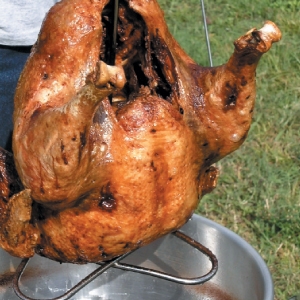Uncle Scott’s Boss Turkey

Marinade
There are several popular brands of injectable marinade, and they come in different flavors. Most supermarkets carry them, but certain sporting goods stores (Dick’s, for example) also carry them. (Our favorite flavor is the creole butter.) Inject the marinade right before frying the turkey. The key is to make as few injection holes as possible. Insert the needle into the bird and empty half of the syringe, and then rotate the needle in another direction (of the breast, for instance). The marinade should be inserted into all areas that have meat that will be eaten (legs, wings, breast, etc.).
Rub/Seasoning
The rub is a blend of seasonings that should be applied to the thawed turkey before frying—both inside the cavity and on the outside skin.
Oil
Before injecting the marinade, place the bird in the pot and fill the pot with water until the bird is covered. Pay attention to where the level of the water is—that will tell you how much oil you'll need to put in the empty pot. Remove the turkey and pat dry with a paper towel. The turkey must be dry (and COMPLETELY THAWED—frozen turkeys that are dropped in the hot oil will explode and turn the pot into a cannon) when it goes in the hot oil.
Preheat
Fill the pot with peanut or canola oil to appropriate level (based on your measurement as described above). Start your propane burner and place the lid on the pot, along with the clip-on thermometer (it will heat faster if covered). The temperature of the oil should be between 325 and 350 degrees. Depending on the weather, the preheating time can vary in length, but will take approximately thirty minutes, so you'll need to factor this into your planning. Keep in mind that when you place the turkey into the pot, the temperature of the oil will drop, sometimes as much as fifty degrees. Therefore, you might want to preheat the oil to approximately 375 degrees so that the temperature will drop to the desired degrees once the turkey is in.
Inserting Turkey into Pot
Once the oil has reached the desired preheated temperature, and you have put the rub on the bird and injected the marinade, it is time to put the turkey in the basket with the legs upright. Remove the clip-on thermometer from the lip of the pot. You need to SLOWLY drop the basket into the hot oil. This way the oil will fill the bird's cavity slowly and you will avoid splattering the oil.
Lower the turkey into the fryer very slowly to avoid splattering the oil on yourself or others.
Once the bird is in, start your watch to keep an eye on the time. If the turkey dropped the temp below 325 degrees, you'll need to turn up the flame. Conversely, if the temperature goes above 350, turn the flame down to lower the temp.
While the bird is cooking, the chief fryer can finally relax for a little bit and partake in football, conversation, or simple rest.
* Cook’s Note: No matter how accurately you measured how much oil you needed, there is a good chance that there will be on overflow of the oil. It's good to have some newspaper and/or kitty litter nearby to help soak up any oil the spills or splashes.
Cooking
Scott’s rule for cooking time is three minutes per pound, plus five minutes. He quips, “Of course, you can always use a meat thermometer to check your progress and make sure it is done . . . but only wimps do this.” For a twenty-pound turkey, cooking time should be approximately 65 minutes.
Done
Once done, turn off the burner and slowly remove the basket that holds the turkey, draining all oil out of basket before totally removing. Remove turkey from fryer basket. (You'll find that the turkey can stick to the insides of the basket, so you need to loosen it either with a knife or other implement.) Place the bird on a platter, bring inside, and carve in your traditional manner.
Clean Up
Allow the oil to thoroughly cool. Place the top back on the pot and let it sit. It will be fine, even if left overnight.
The oil can be recycled. Once cooled, pour it back into its container.
* Cook’s Note: Take an empty plastic gallon milk container and with a knife or scissors, cut out the bottom of it. This makes a big funnel (if you don't have one already) that you can use to pour the oil back into its original container. Pouring it back into the container is usually a job for two people.
Fresh whole turkey (12 to 20 pounds)
Canola or peanut oil (see below)
Marinade (see below)
Rub (see below)
Turkey-frying kit


